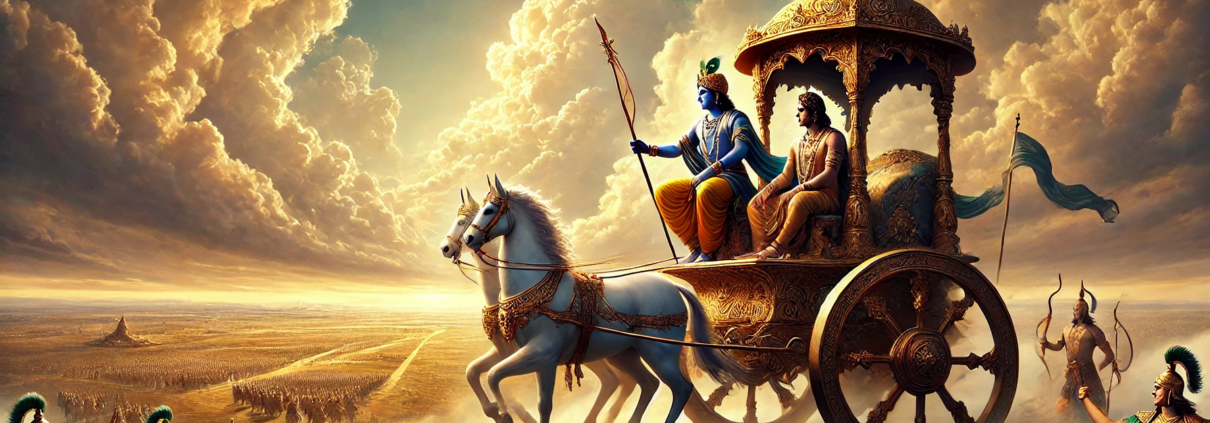The Bhagavad Gita in Brief: A Guide for the Darkest Time
In a world where fear and confusion seem to rule, where even the strongest lose courage, The Bhagavad Gita offers an unshakable foundation. It is not merely a sacred text—it is a chariot offered to us, a vehicle through which we can find clarity, purpose, and the power to rise beyond doubt.
The Scene: A Battle of the Soul
The Bhagavad Gita takes place on the battlefield of Kurukshetra, where two sides of one great family stand ready to fight. Arjuna, the warrior-prince, looks across the field and sees his own brothers, teachers, and kin among the enemy. His heart collapses. How can he fight against those he loves? How can any of this lead to righteousness? He drops his bow, overcome with despair.
At this moment, his charioteer Krishna—who is not just a friend but the Supreme Being in human form—begins to speak. What follows is the ultimate teaching on life, duty, devotion, and liberation.
Why We Must Engage
Krishna does not tell Arjuna to fight out of anger, greed, or ego. He tells him to stand and act because:
1. We are not the doer. Arjuna is not fighting as a separate self, but as an instrument of divine will. The true Self, beyond body and mind, is untouched by battle or loss.
2. The soul is eternal. The body may perish, but the atman (true self) cannot be destroyed. Life and death are but changing garments in the vast play of existence.
3. Dharma calls us to act. Each of us has a purpose, a duty (svadharma) aligned with the greater good. To abandon our calling out of fear is to betray the very reason we are here.
4. Renounce the fruits, not the action. Krishna teaches karma yoga—selfless action. We must engage fully, but without attachment to success or failure. The act of offering our whole heart is itself the reward.
5. Devotion transforms all. When we surrender ourselves in love, trusting the divine, even life’s greatest struggles become paths to liberation.
The Chariot Given to Us
In this great story, Krishna is Arjuna’s charioteer. But he is also our charioteer. The Bhagavad Gita itself is that divine vehicle, carrying us beyond fear, confusion, and despair. It does not promise comfort, but it promises strength. It does not erase struggle, but it reveals its meaning.
Krishna tells us that our real battle is not against others but against our own doubt, our hesitation, our illusions. And even though those we stand against may be our brothers and sisters, the highest love does not mean retreat—it means engaging with courage, with clarity, and with the devotion to uplift all beings.
How We Bring This Into Daily Life
The lesson of the Bhagavad Gita is not just for warriors on a battlefield—it is for all of us, every day. It teaches us how to:
• Show up fully in our work, relationships, and struggles, without being paralyzed by fear.
• Offer everything as a devotional act, where love itself is the purpose, not the result.
• Let go of worry about success or failure, knowing that sincere effort itself is enough.
• Trust in the divine flow of life, surrendering personal ego to something greater.
Krishna offers us the ultimate joy: to live as instruments of love, in service to all, without attachment or fear.
A Call to the Warriors of the Heart
Wherever you stand today—whether in personal crisis, social upheaval, or spiritual exhaustion—the Bhagavad Gita invites you to step into the chariot. The same divine wisdom that guided Arjuna is here for you now.
Do not be afraid. Do not retreat. Act with love, with devotion, and with fearless joy. This alone is victory.
Neem Karoli Baba, affectionately known as Maharajji and best known as the Guru of Ram Das and Larry Brilliant, often emphasized the unity of divine manifestations across different traditions. He expressed that Hanuman, Christ, and Krishna are the same, and to some—embodied the same energy himself.



